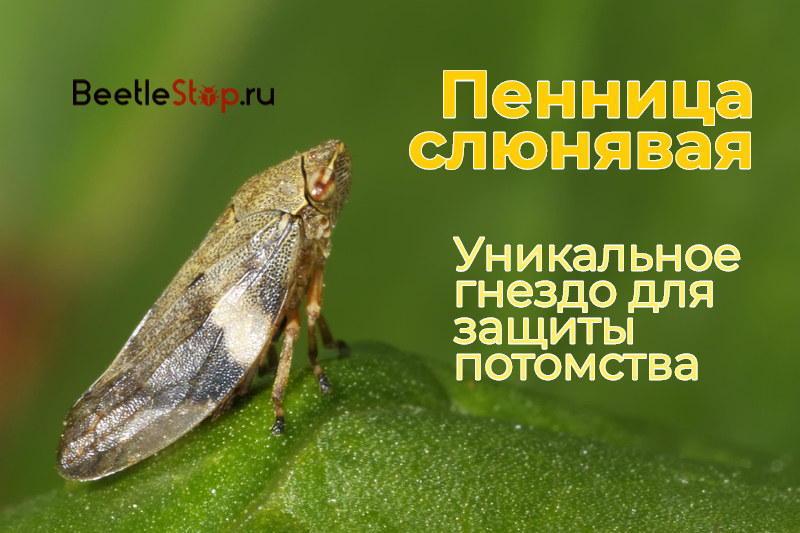Penny drooling - who lives in foam lumps on plants?
On a summer cottage or meadow grass in the spring you can see foamy lumps. At first glance, it is difficult to determine their origin. Oddly enough, this is a nest. Larvae of penicidal cicada live in it. Representatives of the semi-winged squad found a way to hide from the heat and predatory insects. A foamy secret reminiscent of saliva reliably protects larvae from enemies and adverse conditions. Due to the good survival of the offspring, Pennaria slobbering is one of the most common pests.

Description of appearance
Species of cicadas Pennica slobbering or slobber (Philaenusspumarius) is a polyphagous pest found on cultivated, wild and ornamental plants. The body of an adult insect is flattened and stocky, 5-6 mm long. The polymorphic look is characterized by a wide variety of colors. At least 20 color variations are known. Penny drooling can be olive, yellowish or brown with dark spots. Brown, reddish, green individuals are found, light and dark bandages are present on their body. The pattern can be from longitudinal or transverse stripes, spots, geometric shapes.
The head is large, the frontal plate is triangular in shape, the crown is rounded. The insect uses the proboscis to feed. His mouth is sucking. The pronotum is long and wide; at the end it diverges to the sides. Elytra are leathery, fold on the back in the shape of a house, completely cover the abdomen. The upper body and wings are covered with sparse hairs. Feet are hopping. The abdomen consists of 6-9 segments, the females have an ovipositor. Bristles and spines grow on the limbs.
Phytophage distribution
Common slobber is found in most countries of Europe, in Russia, Asia, Japan, and North Africa. The species was introduced to North America and Canada and took root well there. Insects are found in regions with a harsh climate - Murmansk, Khabarovsk, Dudinka, Kamchatka, Primorye.
Information. Pennitsa can fly and run, but in case of danger she makes a powerful jump.
Lifestyle and breeding features
Cicadas prefer to live in dense grass. They can be found in a meadow or in the grass layer of a forest. The mating and breeding season in the middle of Europe falls on September. In the southern regions, Pennica slobbering lays eggs in October or November. Small eggs are left in plant cracks in groups of 30 pieces. On top of the masonry is protected by a wax coating. After leaving the offspring, females and males die. Eggs hibernate; in rare cases, adults can hibernate.
Pennitsa is an insect with incomplete transformation; its larva after molting turns into an adult, excluding the pupal phase. The offspring appears in April-May. Coming out of the eggs, the larvae creep along the feed plant. Outwardly, they are similar to adults, but their covers are soft. Young nymphs cannot jump and fly, therefore it is defenseless in front of predators. Drooling salmon found a way to protect the larvae from danger. Their original way is to create foam.
Insects suck plant juice and secrete a special liquid rich in mucins from the abdomen. These are polysaccharides, which are the main component of saliva and mucus.It gives the substance elasticity and ductility. From the small spiracles on the abdomen, air is squeezed out at the right moment, forming a lush clump of small sticky bubbles. As necessary, the foam layer is replenished. It has several important functions:
- Being under a damp cover allows to avoid drying out on a sunny day.
- The effects of chemicals during insecticidal treatment are difficult.
- Insects do not suffer when the temperature drops.
Information. The development of the larva takes up to 50 days, all this time it is in the foam nest. Adults appear in June-July.
Pest Management Methods
The drooling penny has no taste affection; it feeds on grains, flowers, vegetables, strawberries, currants, grapes, and fruit trees. In total, there are about 170 plants that the phytophage damages. As a result of damage to leaves and stems, there are places for the penetration of various viruses and diseases. Pennica is a carrier of the jaundice virus that infects peach. As a result of the suction of the juice by a large colony of pests, the plant lags behind in development, the leaves curl, the ovaries develop poorly, and the vegetative organs are deformed. How to deal with slobbery pennitsa?
There are several methods that allow you to quickly and safely destroy the pest.
Chemical
With a large accumulation of insects, insecticides can not be dispensed with, it is recommended to treat infected cultures: Aktara, Karbofos, Intavir, Kinmiks. Drugs are diluted according to the instructions and sprayed in the morning.
Folk remedies
To preserve the purity of vegetables and fruits, it is possible to destroy pests using natural means. An effective measure to combat foam drool is the use of a solution of laundry soap (200 g of product per 10 liters of water). Against the pest, infusions of tansy and wormwood help (0.5 kg of grass pour 10 liters of boiling water, insist 3-4 hours). Processing with infusion of garlic gives a good result - 1 cup per bucket of water, insist 1-1.5 hours.
Tip. You can pour wood ash directly onto the foam lumps. This is detrimental to the larvae.
The pest often settles on strawberries so as not to spoil the crop with chemicals, foam nests are easily washed off with water, and insects are collected manually.
Preventative measures
It is better to prevent the appearance of pests than to fight them later. As a preventative measure for the appearance of pennies, it is recommended:
- remove weeds in a timely manner;
- Do not make dense landings;
- apply semi-steam tillage.
Good care will ensure plant health, which means that enemies will not be afraid of them.


 (votes: 16, average rating: 4,44 out of 5)
(votes: 16, average rating: 4,44 out of 5)